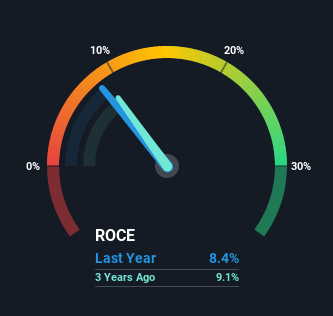- Mexico
- /
- Industrials
- /
- BMV:GCARSO A1
Grupo Carso. de (BMV:GCARSOA1) Is Reinvesting At Lower Rates Of Return

If you're not sure where to start when looking for the next multi-bagger, there are a few key trends you should keep an eye out for. One common approach is to try and find a company with returns on capital employed (ROCE) that are increasing, in conjunction with a growing amount of capital employed. Put simply, these types of businesses are compounding machines, meaning they are continually reinvesting their earnings at ever-higher rates of return. However, after briefly looking over the numbers, we don't think Grupo Carso. de (BMV:GCARSOA1) has the makings of a multi-bagger going forward, but let's have a look at why that may be.
What is Return On Capital Employed (ROCE)?
If you haven't worked with ROCE before, it measures the 'return' (pre-tax profit) a company generates from capital employed in its business. The formula for this calculation on Grupo Carso. de is:
Return on Capital Employed = Earnings Before Interest and Tax (EBIT) ÷ (Total Assets - Current Liabilities)
0.084 = Mex$12b ÷ (Mex$185b - Mex$39b) (Based on the trailing twelve months to December 2021).
Thus, Grupo Carso. de has an ROCE of 8.4%. On its own, that's a low figure but it's around the 8.9% average generated by the Industrials industry.
Check out our latest analysis for Grupo Carso. de

In the above chart we have measured Grupo Carso. de's prior ROCE against its prior performance, but the future is arguably more important. If you'd like to see what analysts are forecasting going forward, you should check out our free report for Grupo Carso. de.
The Trend Of ROCE
On the surface, the trend of ROCE at Grupo Carso. de doesn't inspire confidence. To be more specific, ROCE has fallen from 16% over the last five years. However, given capital employed and revenue have both increased it appears that the business is currently pursuing growth, at the consequence of short term returns. And if the increased capital generates additional returns, the business, and thus shareholders, will benefit in the long run.
On a side note, Grupo Carso. de has done well to pay down its current liabilities to 21% of total assets. So we could link some of this to the decrease in ROCE. Effectively this means their suppliers or short-term creditors are funding less of the business, which reduces some elements of risk. Since the business is basically funding more of its operations with it's own money, you could argue this has made the business less efficient at generating ROCE.
What We Can Learn From Grupo Carso. de's ROCE
In summary, despite lower returns in the short term, we're encouraged to see that Grupo Carso. de is reinvesting for growth and has higher sales as a result. However, despite the promising trends, the stock has fallen 20% over the last five years, so there might be an opportunity here for astute investors. So we think it'd be worthwhile to look further into this stock given the trends look encouraging.
One more thing to note, we've identified 1 warning sign with Grupo Carso. de and understanding this should be part of your investment process.
While Grupo Carso. de may not currently earn the highest returns, we've compiled a list of companies that currently earn more than 25% return on equity. Check out this free list here.
If you're looking to trade Grupo Carso. de, open an account with the lowest-cost platform trusted by professionals, Interactive Brokers.
With clients in over 200 countries and territories, and access to 160 markets, IBKR lets you trade stocks, options, futures, forex, bonds and funds from a single integrated account.
Enjoy no hidden fees, no account minimums, and FX conversion rates as low as 0.03%, far better than what most brokers offer.
Sponsored ContentNew: Manage All Your Stock Portfolios in One Place
We've created the ultimate portfolio companion for stock investors, and it's free.
• Connect an unlimited number of Portfolios and see your total in one currency
• Be alerted to new Warning Signs or Risks via email or mobile
• Track the Fair Value of your stocks
Have feedback on this article? Concerned about the content? Get in touch with us directly. Alternatively, email editorial-team (at) simplywallst.com.
This article by Simply Wall St is general in nature. We provide commentary based on historical data and analyst forecasts only using an unbiased methodology and our articles are not intended to be financial advice. It does not constitute a recommendation to buy or sell any stock, and does not take account of your objectives, or your financial situation. We aim to bring you long-term focused analysis driven by fundamental data. Note that our analysis may not factor in the latest price-sensitive company announcements or qualitative material. Simply Wall St has no position in any stocks mentioned.
About BMV:GCARSO A1
Grupo Carso. de
Engages in the commercial, industrial, infrastructure and construction, and energy sectors.
Excellent balance sheet with acceptable track record.


